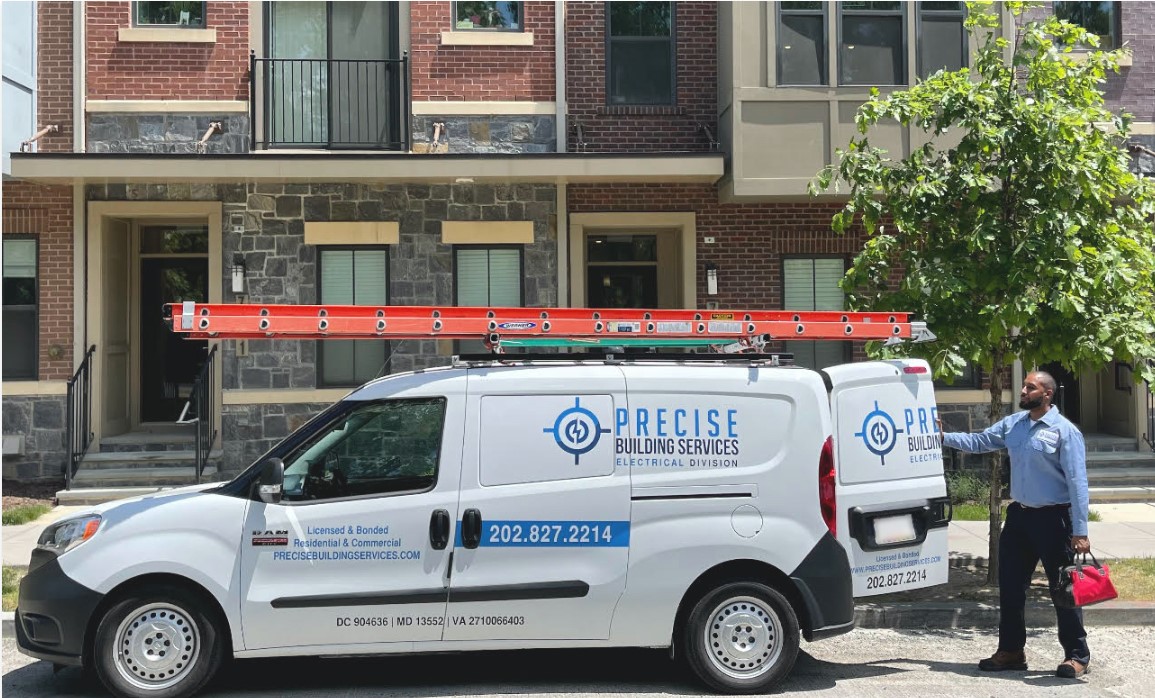Expert Carbon Monoxide Detector Installation & Repair In Washington, DC
More than 20,000 people visit emergency rooms each year due to carbon monoxide poisoning. Carbon monoxide is an invisible gas produced by furnaces, cars and any fuel-burning devices or appliances. Without an alarm, carbon monoxide is almost impossible to detect. a carbon monoxide detector can save lives and, in many cases, are required by local code.
Whether you are uncertain whether your current carbon monoxide detectors are working or if you need to install new carbon monoxide alarms near Washington DC, Precise Building Services can assist in making sure you and your family are safe.
Why You Need Carbon Monoxide Detectors
Carbon monoxide is an odorless, colorless gas. There are several symptoms of carbon monoxide poisoning, but if a home’s occupants are sleeping, they may not notice until it’s too late.
Any fuel-burning source produces carbon monoxide. If not vented properly, carbon monoxide can reach dangerous levels indoors. Breathing in too much carbon monoxide can replace the oxygen in your blood and prevent oxygen from getting to your organs.
All fuel-burning sources that rely on the combustion of gas or wood can produce carbon monoxide, including:
- Furnaces
- Stoves
- Water Heaters
- Fireplaces
- Cars & Trucks
Symptoms of carbon monoxide poisoning include headaches, dizziness, nausea, shortness of breath and loss of consciousness. Carbon monoxide poisoning can also cause brain damage and death. If you suspect you or someone has symptoms of carbon monoxide poisoning, get to fresh air immediately and call 911.
Get Professional Carbon Monoxide Detector Installation Near Washington DC
While some homeowners choose to install detectors themselves, there are several advantages to hiring an electrician like Precise Building Services to install the units. These benefits include:
Knowing how many detectors you need and where to install them. Providing advice on how to maintain the detectors and when they should be replaced. Ensuring compliance with local building codes. Safely replacing detectors wired to the home’s electric system.
We have built our business with safety as our number one priority and are dedicated to ensuring your carbon monoxide detectors are installed correctly. If you think your detectors are broken or you need new ones installed, call the experts at Precise Building Services today!
Carbon Monoxide Detector FAQs
Yes, having a carbon monoxide (CO) detector is still recommended even if you don't have gas appliances. Carbon monoxide can be produced by various sources, including malfunctioning wood-burning stoves, fireplaces, generators, and vehicles in attached garages. It's an odorless, colorless gas that can be deadly in high concentrations. Installing CO detectors on each level of your home helps ensure the safety of occupants by providing an early warning in case of CO buildup from any source, preventing potential health risks.
Installing a carbon monoxide (CO) detector in your home offers crucial safety benefits. CO is an odorless and colorless gas that can be produced by various sources, including gas appliances, heating systems, and combustion devices. A detector provides early warning of dangerous CO levels, allowing occupants to evacuate and seek medical attention if necessary. This preventive measure is especially important as CO poisoning can lead to serious health issues or even fatalities. By promptly detecting and alerting you to CO presence, a detector ensures the well-being of your household.
To detect the presence of carbon monoxide gas in the air, carbon monoxide (CO) detectors continuously monitor the atmosphere. They have sensors that measure CO concentrations and sound an alert when those concentrations go above a predetermined level. Electrochemical sensors, which produce an electrical current when exposed to CO, are used in the majority of detectors. The alarm is set off by this current. Metal oxide semiconductors and biomimetic sensors are examples of additional sensor types. When the alarm goes off, the residents are alerted, allowing them to leave and find fresh air to avoid CO poisoning.
Carbon monoxide (CO) poisoning symptoms resemble those of the flu, including headache, dizziness, nausea, vomiting, weakness, confusion, chest pain, and shortness of breath. Since CO is odorless and colorless, it's often called the "silent killer." Prolonged exposure can lead to unconsciousness, brain damage, and death. Infants, elderly individuals, and pets are particularly vulnerable. If you suspect CO poisoning, immediately evacuate the area, seek fresh air, and seek medical attention. Install CO detectors in your home for early detection.
You should test your carbon monoxide detector at least once a month to ensure it is functioning properly. Most detectors have a test button that, when pressed, will activate the alarm. This regular testing helps confirm that the batteries and internal circuitry are working correctly. Additionally, replace the batteries at least once a year, or as recommended by the manufacturer. Regular maintenance and testing can help ensure your detector provides reliable protection against carbon monoxide poisoning.





